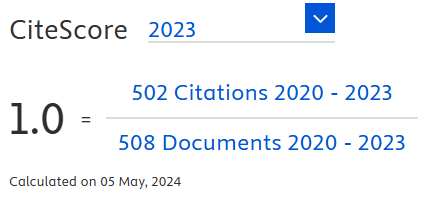Dehydrogenase: A key soil health indicator for Thar Desert, India
DOI:
https://doi.org/10.18006/2024.12(6).876.886Keywords:
Soil biology, Micronutrients, Soil fertility, Rhizosphere, Nutrient uptakeAbstract
A field study was conducted to identify a potential fertility indicator for the soils of the Thar Desert. The study area included eight districts, covering a total of 156,580 km². This region experiences a wide range of climatic conditions, with annual rainfall varying from 177 mm to 409 mm and temperatures fluctuating between 8°C and 46°C. Surface soil samples (0-10 cm depth) were collected from agricultural fields across the region, representing various soil properties and cropping patterns. The soil texture varied from sandy loam to loamy sand, and the wet colour ranged from dark reddish-brown to dark yellowish-brown. The physicochemical and biological properties of the soil samples from different areas of the Thar Desert were as follows: moisture content ranged from 2.19% to 8.73%, bulk density from 1.18 to 1.33 Mg/m³, particle density from 1.82 to 4.11 Mg/m³, pore space percentage from 26.74% to 68.53%, solid space percentage from 31.47% to 73.26%, pH values from 7.69 to 8.43, and electrical conductivity from 0.12 to 0.17 dS/m. Furthermore, the soil organic carbon content ranged from 0.82% to 1.21%, while organic matter content varied between 1.41% and 2.09%. The available nitrogen was found to be between 285.69 and 365.87 kg/ha, phosphorus ranged from 19.84 to 24.77 kg/ha, potassium levels ranged from 214.29 to 314.72 kg/ha, and sulfur levels varied between 16.08 and 23.62 ppm. Additionally, nitrogenase retention time was recorded at 1.391 to 1.547 minutes, phosphatase activity ranged from 269.44 to 343.15 µg p-nitrophenol g⁻¹ h⁻¹, and dehydrogenase enzyme activity ranged from 250.33 to 309.34 µg TPF/g/24 h. The results demonstrated that soil properties varied across the Thar Desert. This study provided valuable insights into the physicochemical and biological characteristics of the soil in the Thar Desert of Rajasthan, India. Notably, a significant positive correlation (r² value of 0.95) was found between dehydrogenase enzyme activity and various soil fertility parameters, suggesting that dehydrogenase could serve as a potential biological indicator of soil fertility.
References
Abba, H.M., Sawa, F.B.J., Gani, A.M., Abdul, S. D., & Iliyaches, M. (2014). Soil Physico Chemical Characteristics of Kanawa Forest Reserve (KFR), Gombe State, Nigeria. IOSR Journal of Environmental Science, Toxicology and Food Technology, 10(2), 68-75.
Adak, T., Singha, A., Kumar, K., Shukla, S.K., Singh, A., & Singh, V.K. (2014). Soil organic carbon, dehydrogenase activity, nutrient availability, and leaf nutrient content as affected by organic and inorganic sources of nutrients in mango orchard soil. Journal of Soil Science and Plant Nutrition, 14(2), 394-402. http://dx.doi.org/10.4067/s0718-95162014005000031 DOI: https://doi.org/10.4067/S0718-95162014005000031
Aseri, G.K., & Tarafdar, J.C. (2006). Fluorescein diacetate: a potential biological indicator for arid soils. Arid Land Research and Management, 20(2), 87–99. https://doi.org/10.1080/ 15324980500544473. DOI: https://doi.org/10.1080/15324980500544473
Av, P., & Ghabane, V.V. (2018). Assessment of available soil nutrient status in black soils of Akola district, Maharashtra. Journal of Pharmacognosy and Phytochemistry, 7(5), 1124-1129.
Bhatti, S.S., Kumar, V., Singh, N., Sambyal, V., Singh, J., Katnoria, J.K., & Nagpal, A.K. (2016). Physico-chemical properties and heavy metals contents of soils and Kharif crops of Punjab, India. Procedia Environmental Sciences, 35, 801–808. DOI: https://doi.org/10.1016/j.proenv.2016.07.096
Bhavya, V.P., Kumar, A.S., Alur, A., Shivkumar, K.M., & Shivanna, M. (2018). Soil chemical properties under different horticultural cropping systems with different depths. Indian Journal of Pure & Applied Biosciences, 6(1), 1645-1651. http://dx.doi.org/10.18782/2320-7051.6115 DOI: https://doi.org/10.18782/2320-7051.6115
Bouyoucos, G.J. (1927). The hydrometer is a new method for the mechanical analysis of soil. Soil science, 23, 343- 353. http://dx.doi.org/10.1097/00010694-192705000-00002 DOI: https://doi.org/10.1097/00010694-192705000-00002
Casida, L., Klein, D., & Santoro, T. (1964). Soil dehydrogenase activity. Soil science, 98, 371-376. DOI: 10.1097/00010694-196412000-00004 DOI: https://doi.org/10.1097/00010694-196412000-00004
Chen, L., Li, C., Zhang, Z., Feng, Q., Xi, H., Guo, R., & Et, A.L. (2024). Landscape differentiationof soil bacteria and bacteria-soil-vegetation interactions in desert-oasis ecosystems. Global and Planetary Change, 232, 104323 https://doi.org/10.1016/j. gloplacha.2023.104323 DOI: https://doi.org/10.1016/j.gloplacha.2023.104323
Chesnin, L., & Yien, C. (1950). Turbidimetric determination of available sulfates. Proceedings of the Soil Science Society of America, 14, 149-151. http://dx.doi.org/10.2136/ sssaj1951.036159950015000c0032x DOI: https://doi.org/10.2136/sssaj1951.036159950015000C0032x
Choudhary, S., Swaroop, N., & Thomas, T. (2020). Assessment on physico-chemical properties of soil from different blocks of Rajsamand district of Rajasthan, India. International Journal of Current Microbiology and Applied Sciences, 9(9), 1718-1722. DOI: https://doi.org/10.20546/ijcmas.2020.909.212
Dewangan, S. K., Kumari, L., Minj, P., Kumari, J., & Sahu, R. (2023). The effects of soil ph on soil health and environmental sustainability: a review. Journal of Emerging Technologies and Innovative Research, 10 (6), 611-616.
Dilworth, M.J. (1966). Acetylene reduction by nitrogen-fixing preparations from clostridium pasteurianum. Biochimica et Biophysica Acta, 127, 285-294. https://doi.org/10.1016/0304-4165(66)90383-7 DOI: https://doi.org/10.1016/0304-4165(66)90383-7
Gautam, M.K., Ghosh, A.K., Latare, A.M., Singh, R.K., Singh, U.P., & Maurya, A. (2018). Characterization of Physico-chemical properties of red soil in Mirzapur district of Uttar Pradesh. International Journal of Chemical Studies, 6(3), 1067-1073.
Geetha, S., Reddy, B., & Hemalatha, K.P.J. (2017). Physico-chemical analysis of selected agricultural soil samples in Kommangipanchythi, Chintapalli mandal, Visakhapatnam. International Journal of Information Retrieval Research, 4 (1), 3530–3532.
Jackson, M. (1958). The pH was determined in 1:2 soil water suspensions using a digital pH meter. Soil chemical analysis. Prentice HallIndia, NewDelhi.
Jaiswal, P.C. (2014). Soil plant and water analysis. Edn 3, Kalyani publisher, NewDelhi, pp. 120.
Kaur, J., & Kaur, G. (2021). Dehydrogenase Activity as a Biological Indicator of Soil Health. Chemical Science Review and Letters, 10 (39), 326-329. 10.37273/chesci.cs205205338.
Khanday, M.D., Wani, J.A., Ram, D., & Kumar, S. (2018). Depth-wise distribution of available nutrients of soils of horticultural growing areas of ganderbal district of Kashmir valley. Journal of Pharmacognosy and Phytochemistry, 7(1), 19-22.
Kour, S., & Jalali, V.K. (2008). Forms of sulfur and their relationship in soils of different agro-climatic zones of Jammu region. Journal of the Indian Society of Soil Science, 56, 309-312.
Kumar, M., Kar, A., Raina, P., Singh, S.K., Moharana, P. C., & Chauhan, J.S. (2021). Assessment and mapping of available soil nutrients using gis for nutrient management in hot arid regions of Northwestern India. Journal of the Indian Society of Soil Science, 69 (2), 119-132. 10.5958/0974-0228.2021.00035.9 DOI: https://doi.org/10.5958/0974-0228.2021.00035.9
Kumar, M., Kar, A., Raina, P., Singh, S.K., Moharana, P.C., & Chauhan, J.C. (2019). Spatial variability of available nutrients in the Shekhawati region of Thar Desert, India. Journal of the Indian Society of Soil Science, 67, 21-33. DOI: https://doi.org/10.5958/0974-0228.2019.00003.3
Kumar, M., Kumar, N., Bharose, R., & Kumar, R. (2018). Morphology, physicochemical properties, and classification of salt-affected soils of Rudauli block, Faizabad, UttarPradesh. Annals of Plant Sciences, 20(1), 26-30.
Kumar, M., Singh, S.K., Raina, P., & Sharma, B.K. (2011). Status of available major and micronutrients in arid soils of Churu district of western Rajasthan. Journal of the Indian Society of Soil Science, 59, 188-192.
Kumari, N., Singh, A.K., Agarwal, S., & Thomas, T. (2021). Assessment of physico-chemical properties of soil from different blocks of Jhunjhunu district, Rajasthan. The Pharma Innovation Journal, 10(12), 2247–2254.
Ladwani, K.D., Ladwani, K.D., Manik, V.S., & Ramteke, D. S. (2012). Impact of Domestic Wastewater Irrigation on soil properties and crop yield. International Journal of Scientific and Research Publications, 2(10), 2250-3153.
López-Hernández, D., Brossard, M., Fardeau, J.C., & Lepage, M. (2006). Effect of different termite feeding groups on P sorption and P availability in African and South American savannas. Biology and Fertility of Soils, 42, 207–214. https://doi.org/10.1007/s00374-005-0017-x DOI: https://doi.org/10.1007/s00374-005-0017-x
Margalef, O., Sardans, J., Fernández-Martínez, M., Molowny-Horas, R., Janssens, I. A., et al. (2017). Global patterns of phosphatase activity in natural soils. Scientific reports, 7(1), 1337. https://doi.org/10.1038/s41598-017-01418-8 DOI: https://doi.org/10.1038/s41598-017-01418-8
Meena, A., & Rao, K.S. (2021). Assessment of soil microbial and enzyme activity in the rhizosphere zone under different land use/cover of a semiarid region, India. Ecological Processes, 10, 16. https://doi.org/10.1186/s13717-021-00288-3 DOI: https://doi.org/10.1186/s13717-021-00288-3
Munsell, A. (1954). Munsell soil color chart. First edition. Munsell Color Company Inc. 2441 n, Baltimore, Maryland.
Muthuvel, P., Udayasoorian, C., Natesan, R., & Ramaswami, P. (1992). Introduction to soil analysis. First edition. Tamil NaduAgricultural University, Coimbatore.
Naphade, M., Sidhu, G.S., Patil, V.D., & Shinde, R. (2021). Assessment of physico-chemical properties and micronutrient status of Jalgaon district, Maharashtra states, India. International Journal of Current Microbiology and Applied Sciences, 10(03), 52–59. DOI: https://doi.org/10.20546/ijcmas.2021.1003.009 DOI: https://doi.org/10.5958/2394-448X.2021.00018.3
Olsen, S.R., Cole, C.V., & Watanabe, F.S. (1954). Estimation of Available Phosphorus in Soils by Extraction with Sodium Bicarbonate. USDA Circular No. 939, US Government Printing Office, Washington DC.
Rajshri, S., Sidhu, G. S., Patil, V. D., & Naphade, M. (2021). Evaluation of physicochemical properties in hot semi-arid eco-region of Beed district, Maharashtra India. International Journal of Current Microbiology and Applied Sciences, 10(03), 45–51. https://doi.org/10.20546/ijcmas.2021.1003.008
Saxena, A., Thomas, T., Nandan, R., & Khatana, S. (2021). Evaluation of physico-chemical properties of soil from different blocks of Kanpur Nagar district, Uttar Pradesh. The Pharma Innovation Journal, 10 (10), 252-259.
Sharma, C.M., Gairola, S., Ghildiyal, S.K., & Suyal, S. (2010). Physical properties of soils about forst composition in moist temperate valley slopes of the central western Himalaya. Journal of Forest Science, 26(2), 117-129.
Singh, S.K., Kumar, M., Sharma, B.K., & Tarafdar, J.C. (2007). Deletion of organic carbon, phosphorus, and potassium under pearl millet-based cropping system in the arid region of India. Arid Land Research and Management, 21, 119-131. DOI: https://doi.org/10.1080/15324980701236101
Subbiah, B.V., & Asija, C.L. (1956). A rapid procedure for the estimation of available nitrogen in soils. Current Science, 25, 259-260.
Tabatabai, M.A., & Bremner, J.M. (1969). Use of p-nitrophenyl phosphate for assay of soil phosphatase activity. Soil Biology & Biochemistry, 1(4), 301-307. http://dx.doi.org/10.1016/0038-0717(69)90012-1 DOI: https://doi.org/10.1016/0038-0717(69)90012-1
Tale, K.S., & Ingole, S. (2015). Chemical science review and letters a review on the role of physicochemical properties in soil quality. Chemical Science Review and Letters, 13, 57–66.
Taylor, S. A. (1955). Field determinations of soil moisture. Agricultural engineering, 36, 654-659.
Threatt, S.D., & Rees, D.C. (2023). Biological nitrogen fixation in theory, practice, and reality: a perspective on the molybdenum nitrogenase system. FEBS Letters, 597(1), 45-58. DOI: 10.1002/1873-3468.14534. DOI: https://doi.org/10.1002/1873-3468.14534
Toth, S.J., & Prince, A.L. (1949). Estimation of cation exchange capacity and exchangeable ca, k, and na content of soil by flame photometer technique. Soil Science, 67, 439-445. https://doi.org/10.1097/00010694-194906000-00003 DOI: https://doi.org/10.1097/00010694-194906000-00003
Walkley, A. (1947). A critical examination of a rapid method for determining organic carbon in soils—effect of variations in digestion conditions and of inorganic soil constituents. Soil Science, 63 (4), 251-264. http://dx.doi.org/10.1097/00010694-194704000-00001 DOI: https://doi.org/10.1097/00010694-194704000-00001
Wang, Y., Zhong, B., Shafi, M., Ma, J., Guo, J., et al. (2018). Effects of biochar on growth, and heavy metals accumulation of Moso bamboo soil physical properties, and heavy metals solubility in soil. Chemosphere, 219, 510–516. DOI: https://doi.org/10.1016/j.chemosphere.2018.11.159
Wilcox, L.V. (1950). Electrical conductivity. Journal American Water Works Association, 42, 775-776. DOI: https://doi.org/10.1002/j.1551-8833.1950.tb18892.x
Wolf, M.K., Wiesmeier, M., & Macholdt, J. (2023). Importance of soil fertility for climate-resilient cropping systems: The farmer's perspective. Soil Security, 13, 100119. DOI: https://doi.org/10.1016/j.soisec.2023.100119. DOI: https://doi.org/10.1016/j.soisec.2023.100119
Wu, N., Zhang, Y.M., & Downing, A. (2009). Comparative study of nitrogenase activity in different types of biological soil crusts in the Gurbantunggut desert, northwestern China. Journal of Arid Environments, 73(9), 828–833. https://doi.org/10.1016/ j.jaridenv.2009.04.002. DOI: https://doi.org/10.1016/j.jaridenv.2009.04.002
Zhong, Y., Yan, W., Canisares, L.P., Wang, S., Brodie, E.L., & Schrodt, F. (2022). Alterations in soil pH emerge as a key driver of the impact of global change on soil microbial nitrogen cycling: evidence from a global meta-analysis. Global Ecology and Biogeography, 32, 145–165. https://doi.org/10.1111/geb.13616. DOI: https://doi.org/10.1111/geb.13616
Downloads
Published
How to Cite
License
Copyright (c) 2025 Journal of Experimental Biology and Agricultural Sciences

This work is licensed under a Creative Commons Attribution-NonCommercial 4.0 International License.












